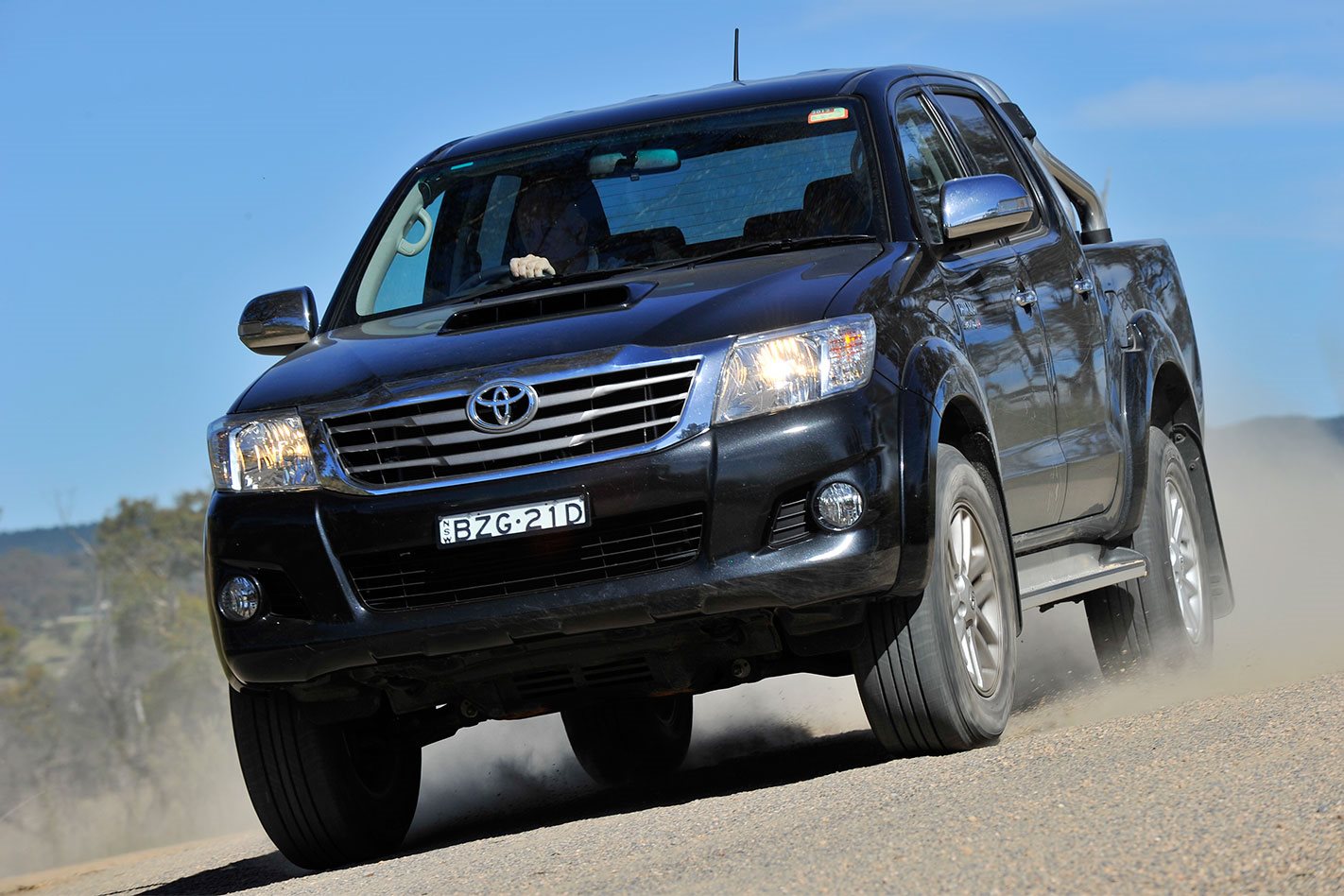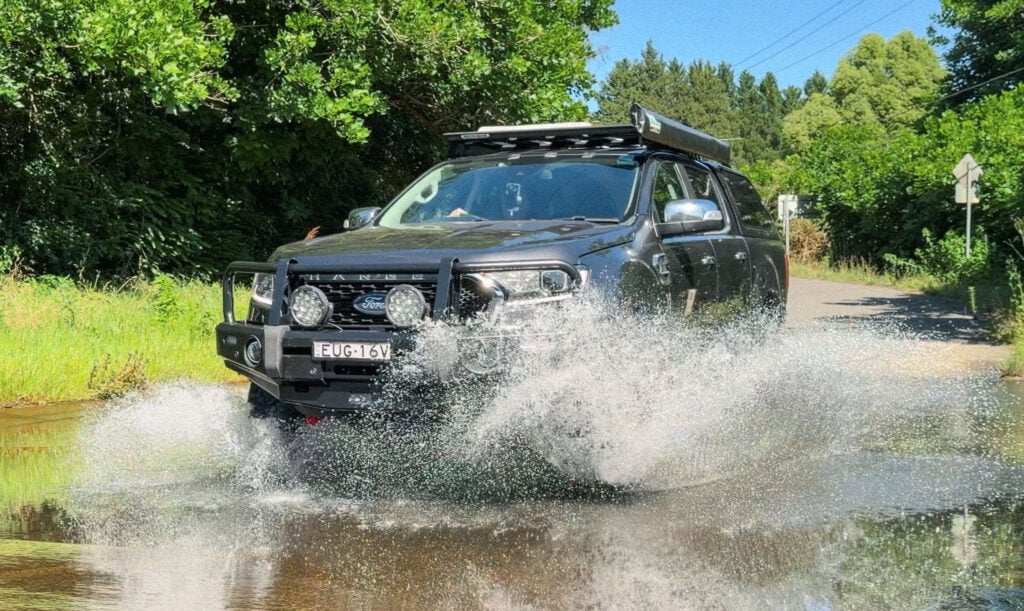
Score breakdown
Things we like
- Wide dealer network
- Reliability
- Resale value
Not so much
- Built on a 10-year old platform
What stands out?
The Toyota HiLux is the most popular ute in Australia, and in four-wheel drive form it is also the best-selling 4WD vehicle. Most people choose diesel 4WD dual cabs, which are the most expensive HiLuxes but very versatile. This review covers only HiLuxes produced prior to the major model update of October 2015.
What might bug me?
Not much, but the hard ride when lightly loaded is a typical ute problem.And while the Hilux is not as bulky as some direct competitors, it’s still a big vehicle and awkward in tight car parks.
What body styles are there?
Single-cab chassis; extra-cab chassis and Pick-Up; double-cab chassis and Pick-Up.Pick-Up models come with a factory tub at the rear, while cab-chassis models allow their buyers to fit a tray of their choice, either a dealer-fit accessory from Toyota or a tray from an after-market supplier.The Hilux is available as rear-wheel-drive only vehicle, or with dual-range four-wheel drive. It is classed as a commercial light pick-up.
What features do all versions have?
Two airbags, directly in front of the driver and front passenger.Bluetooth connectivity and a USB plug for easy charging of phones.A decent audio head unit, with control buttons on the steering wheel.The basic Workmate does not have air-conditioning. But dealers tend not to stock them without what is seen as an essential feature these days, and so you can add the cost of air-con to the base price.The warranty is three years or 100,000km, and all HiLux models come with capped-price servicing for the first three years or 60,000km, whichever occurs first.
Which engine uses least fuel, and why wouldn’t I choose it?
The most fuel-efficient engine available in the HiLux is the 3.0-litre four-cylinder turbo diesel, which on the official test uses 8.7 litres/100km in a four-wheel drive auto (urban and country).This engine is also economical in the real world, where it uses about 10.5 litres/100km in 4WD manuals, and 11 litres/100km in 4WD automatics.In two-wheel drive models, which are manual only, it uses about 9.5 litres/100km in typical use.This is engine is by far the most popular in a HiLux. More than 99 percent of HiLux 4WD buyers go for the diesel, and these comprise two-thirds of Hilux buyers overall. It works well with the five-speed auto transmission, and its strong pull from low engine speeds makes it the pick for towing or if you’ll be regularly loading the tray. The other gearbox option is a five-speed manual, which is also easy to use.A cheaper, 2.7-litre four-cylinder petrol engine is offered, but only in 2WD models, where it is easily the most popular engine.For best performance in 2WD or 4WD, the largely unloved 4.0-litre V6 petrol is the pick. But it does get thirsty when worked hard.
What key features do I get if I spend more?
The basic WorkMate, which is only available in 2WD, comes with vinyl seats and vinyl floor coverings. You’ll also be winding your own windows up or down and manually adjusting the mirrors.The Hilux SR adds cloth seats, power windows, and cruise control. Extra Cab and Double Cab 4WD versions get four more airbags: side airbags protecting the upper body of front occupants; and curtain airbags protecting the heads of front and rear occupants from side impacts.The SR5 adds carpets, fancier alloy wheels, a reversing camera, climate-control air-conditioning that maintains a set temperature, headlights that switch on automatically when it gets dark, and lashings of chrome topped off with the rollover bar. There is a six-speaker sound system. The SR5 is only available as an Extra-Cab or Double Cab.Electronic stability control, which can control a slide and is credited with reducing crashes, comes on all 4WD HiLuxes. This feature is not mandatory on vehicles classed as commercial, such as the HiLux.Not all bodies and combinations are available in each trim level, but there is a host of combinations to cover everything from basic work vehicles to well appointed five-seat family transport.
Does any upgrade have a down side?
Carpets and cloth seats need more looking after than the vinyl items on the more basic work versions.The chrome roll-over or ‘sports’ bar generates wind noise in some conditions.Only white paint is available as standard. All other colours are extra-cost options.
How comfortable is it?
The HiLux has a comfortable and easy to live with cabin, with big, easy to operate controls.The basic fit-out of the Workmate gives it a spartan feel but it’s easy to clean and maintain.By the time you get to the SR5, the materials and equipment levels are more akin to those of a passenger car. You can even order leather seats as option.Nevertheless the HiLux, like its competitors utes, is more truck than car, something reflected in its basic design.The rear is suspended with stiff leaf springs, for example, and it is a live-axle setup rather than a more subtle independent configuration.That means the ride can be hard and uncomfortable on rough roads, especially when there is no load in the back. Having weight in the tray or tub, or even a canopy fitted at the back, will help smooth things out.
What about safety?
Because of its commercial background and age, the HiLux lags behind in some areas of safety. For example, no 2WD model has electronic stability control, a feature with proven benefits.Only SR5 models have a reversing camera, something that makes backing-up more of a challenge in something this long.(To see a list of the safety features on any model, select the car and look under the features tab. Safety-related features are listed in red.)Nevertheless, the Australasian New Car Assessment Program (ANCAP) has awarded all 4WD HiLux models the maximum five stars for safety. Workmate single-cab 2WD models get four stars.
I like driving – will I enjoy this car?
The HiLux is designed more for work than for driving pleasure or handling precision. It’s a big and bulky vehicle by passenger-car standards, although not as big as some direct competitors.The diesel engine is not as quiet as some newer alternatives, but its strong response low in the rev range makes for relaxed driving.The optional 4.0 litre V6 petrol engine endows the Hilux with plenty of punch.One significant plus with the Hilux is its reliability, something that bodes well for those looking to use it in more remote locations. Toyota also has the biggest service network, so parts and repair back up is second to none – and especially away from the major service centres.
How is life in the rear seats?
Dual-cab models bring seating for five, although the rear seat is not as comfortable as a passenger wagon’s nor as spacious as those in some alternative utes such as the Ford Ranger, Mazda BT-50 and Volkswagen Amarok.Extra Cab models have two fold-down jump seats for occasional, short-distance use.
How is it for carrying stuff?
Being a ute, the Hilux is purpose-made for carrying stuff. Single-cab 2WD models have the biggest tray and payloads rated up to 1460kg, the weight of the tray and any passengers not included.Double-cab models have a smaller tub or tray and their payloads (not including any passengers) fall to 835kg, which is about 200kg less than the best among the alternative utes.Note that these are on-paper maximum weights: use caution (in any ute) if you want to drive with loads approaching these limits.Tow capacity for the HiLux is up to 2500kg, which is 1000kg less than class leaders.
Where is it made?
All Australian-delivered HiLux models are made in Thailand.
What might I miss that similar cars have?
The HiLux cannot match the performance of the Ford Ranger and Mazda BT-50, or the refinement of the Volkswagen Amarok. These utes also offer better on-road ride and handling, and in 4WD form, more off-road ability.Some utes have better safety credentials.Other alternatives include the Holden Colorado, Mitsubishi Triton, Nissan Navara, and Isuzu D-Max.
I like this car, but I can’t choose which version. Can you help?
The SR5 Double Cab 4WD is the pick for families. It comes with a reversing camera and a better equipped, more comfortable interior. Commercial buyers will prefer the cheaper 2WD variants.
Are there plans to update this model soon?
The current model went on sale in late 2005 and was replaced with an all-new model in October 2015. The new model is nicer inside, better off-road, better to drive, and more comfortable to ride in. It can also tow a heavier trailer.
Score breakdown
Things we like
- Wide dealer network
- Reliability
- Resale value
Not so much
- Built on a 10-year old platform



